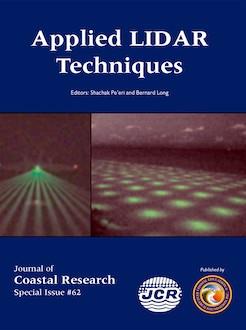The scope of this research is to assess benthoscape discrimination by airborne light detection and ranging (LIDAR) bathymetry (ALB) on the basis of statistical parameters derived from the LIDAR waveforms, textural information, and local spatial statistics. Analysis of the underwater camera stations allowed clustering of the stations into groups on the basis of their habitat composition (β-diversity). Twelve descriptive statistics describing the shape of the bottom part of the waveform, also called 12 benthic parameters, were used for discriminating four benthic habitats. A K-means classification and a supervised method based on the Support Vector Machine (SVM) were applied to this dataset, and overall accuracies of 67.7% and 89.9% were obtained, respectively. Geostatistical analyses, using 11 textural measures, defined by the gray-level occurrence matrix (GLOM) and the gray-level co-occurrence matrix (GLCM), and three local spatial statistics were then applied to the 12 benthic parameters to enhance the SVM classification performance. The assessment of the contribution of geostatistics into benthic class segmentation was achieved by computation of separability distance. Mean (from the GLOM), mean (from the GLCM) and the local Getis-Ord statistic yielded the best rates of discrimination. These added metrics, integrated with bands related to the 12 benthic parameters, showed that the rate of correct (supervised) classification was thereby improved and increased by 5.3%. Finally, the first four principal components (PCs) (i.e., 90.41% of the 12 parameter variances, boosted by the three best geostatistics) brought out an overall accuracy of 93.3%, showing evidence for optimizing the classification processing.
BioOne.org will be down briefly for maintenance on 17 December 2024 between 18:00-22:00 Pacific Time US. We apologize for any inconvenience.
How to translate text using browser tools
1 March 2011
Benthic Classifications Using Bathymetric LIDAR Waveforms and Integration of Local Spatial Statistics and Textural Features
Antoine Collin,
Bernard Long,
Phillippe Archambault
ACCESS THE FULL ARTICLE
<
Previous Article
|
Bathymetric LIDAR
classification
habitat
spatial statistics
texture
waveforms





